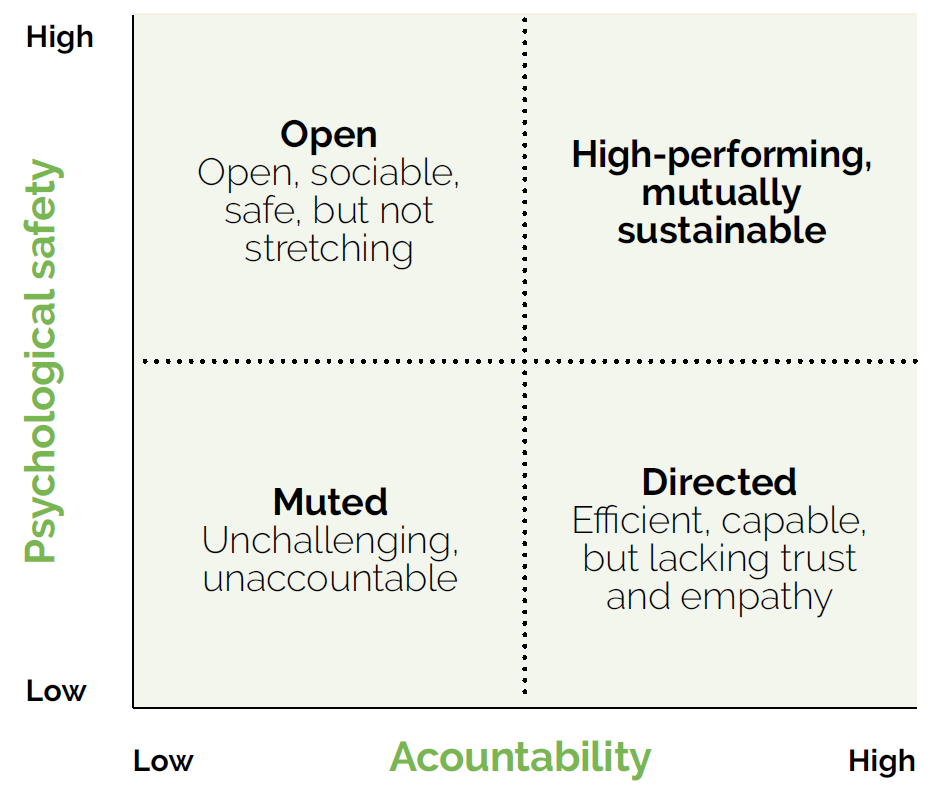Professor Amy Edmondson of Harvard Business School has conducted extensive research into psychological safety and defines it as a “shared belief held by members of a team that the team is safe for interpersonal risk-taking”.
As Neil Perkins discusses in his new IPA white paper Partnering for Growth - Creating mutually sustainable commercial relationships for clients and agencies, creating a psychologically safe environment across the client and agency team is critical to doing the best work.
In her renowned TEDx talk on psychological safety, Amy Edmondson lays out three essential strategies that teams can apply to help foster an environment of psychological safety:
- Framing work as learning, rather than execution problems: placing the emphasis on learning helps encourage greater collaboration and knowledge sharing, alongside valuing different inputs and more effectively dealing with uncertainty
- Acknowledging fallibility: having the humility to recognise when you don’t have all the answers, acknowledging when something is outside the domain of your expertise, encouraging diverse perspectives to help solve problems better
- Model curiosity by asking a lot of questions: curiosity can be like a superpower for a client/agency team, encouraging everyone to contribute and generating new possibilities in the search for answers
There are important behavioural strategies here which are relevant for creating mutually sustainable client/agency relations. Framing work as learning rather than simply execution embeds continuous improvement and adaptability over time, which means that the relationship and the value that it creates is more likely to evolve in productive ways.
Continually exploring new possibilities alongside delivering business as usual builds new value as well as optimising existing assets. Encouraging a diversity of perspectives and acknowledging when the limits of domain knowledge have been reached encourages a broader range of inputs and can lead to greater trust, learning and improved problem-solving.
Edmondson also stresses the importance of combining psychological safety with accountability, and this too is an important framing for mutuality in client/agency relations. Too much psychological safety and not enough accountability can mean that the relationship is comfortable but there is a risk of complacency. Too much accountability and a lack of psychological safety may lead to path dependence and team members not challenging assumptions or raising new ideas.

Both sides in the relationship need to be deliberate in designing a union that amplifies the right behaviours and that balances psychological safety with a focus on accountability in order to achieve the best outcomes and supporting mutuality.
You should have a clear framework of responsibilities but if the relationships aren’t there it means nothing.
Measuring psychological safety
It can be difficult to assess the level of psychological safety across a client/agency team, and even harder to track it over time. One useful technique is to use the original seven statements Amy Edmondson set out in her definitive initial study.
- If I make a mistake in this team, it is held against me.
- Members of this team are able to bring up problems and tough issues.
- People on this team sometimes reject others for being different.
- It is safe to take a risk in this team.
- It is difficult to ask other members of this team for help.
- No one on this team would deliberately act in a way that undermines my efforts.
- Working with members of this team, my unique skills and talents are valued and utilized.
Using a simple survey that asks team members to rate against a numerical scale for these seven statements enables the team to identify areas that need to be addressed. The responses can be anonymised, surveys done regularly to track ratings over time, and the results used as the basis for discussion in client/agency team updates or review sessions.
Measuring team effectiveness
How often is the effectiveness of client/agency teams actually measured? From their work into high-performing teams Google has developed a process for assessing team effectiveness and there are some useful practices that can be drawn out for client/agency teams.
Define what makes a team:
There are multiple potential definitions for what really constitutes a team, ranging from a loosely associated group of work colleagues to a tightly defined core group of staff. For client/agency teams it’s important to define the scope of who on both the client and agency sides should be included
Define ‘effectiveness’
When thinking about the measures, it’s important to be clear about how effectiveness should be defined. The obvious focus will naturally be on outcomes related to the work but there may well be other useful performance measures that can be used alongside this to combine quantitative metrics with qualitative assessment of how the team is working. For example, Google found that whilst senior leaders were most concerned with results, team members believed culture to be important to performance, and team leads focused on a combination of big-picture and individual concerns, including ownership, vision and goals.
This is an extract from Partnering for Growth by Neil Perkin, which explores sustainable commercial relationships for clients and agencies with specific looks at creating mutually sustainable growth, trust, collaboration and psychological safety, longevity, and creating ‘anti-fragile’ relationships. The full report is available to purchase from £25.
Watch Neil unveil his research at the 2022 IPA Business Growth Conference:
The opinions expressed here are those of the author and were submitted in accordance with the IPA terms and conditions regarding the uploading and contribution of content to the IPA newsletters, IPA website, or other IPA media, and should not be interpreted as representing the opinion of the IPA.



